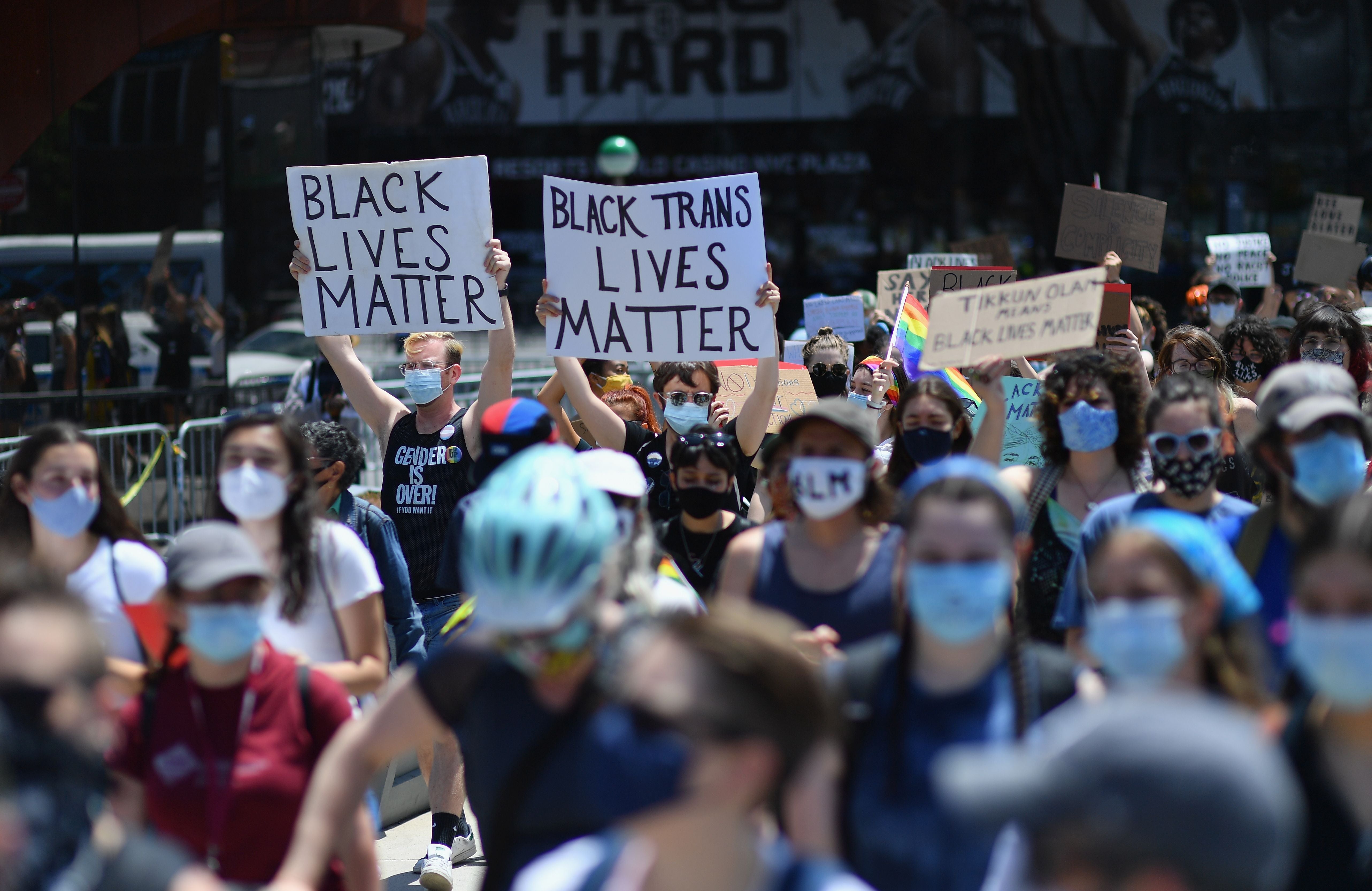The deadly epidemic we must acknowledge this Pride - the murder of transgender people of colour
‘Transgender people of colour are much more likely to face this kind of harassment and outright violence from white police officers than other people’, activists tell Josh Marcus


Your support helps us to tell the story
From reproductive rights to climate change to Big Tech, The Independent is on the ground when the story is developing. Whether it's investigating the financials of Elon Musk's pro-Trump PAC or producing our latest documentary, 'The A Word', which shines a light on the American women fighting for reproductive rights, we know how important it is to parse out the facts from the messaging.
At such a critical moment in US history, we need reporters on the ground. Your donation allows us to keep sending journalists to speak to both sides of the story.
The Independent is trusted by Americans across the entire political spectrum. And unlike many other quality news outlets, we choose not to lock Americans out of our reporting and analysis with paywalls. We believe quality journalism should be available to everyone, paid for by those who can afford it.
Your support makes all the difference.On 14 June, during a summer of expansive nationwide protests against police brutality in the wake of George Floyd’s murder, an estimated 15,000 people gathered in Brooklyn, New York for Brooklyn Liberation, a rally for Black trans lives.
It’s believed to be the largest ever gathering of its kind, and it was a reminder about the many ways the fight for Black and trans justice are bound together historically, particularly when it comes to pushing back against police violence. One of the first people killed by police after Mr Floyd was Tony McDade, a 38-year-old Black transgender man, in Florida.
Now, a year on from George Floyd’s murder, activists and organisers say there’s a new energy around making the criminal justice system a more just place for trans people.
Still, they warn there’s a long way to go before trans lives, subject to both universal and extremely specific forms of discrimination and violence, truly matter to police and society at large.
The current criminal justice landscape for trans people is dire. They’re nearly four times more likely to experience police violence than cisgender people, while more than 20 per cent of Black trans women will be incarcerated at one point their life, a percentage far higher than that of the general population.
As of 2019, only 10 of the 25 biggest police departments included gender identity language in their non-discrimination policies, according to the National Center for Transgender Equality (NCTE). More than half of trans people the NCTE surveyed said they were harassed or abused when they interacted with law enforcement, and more than half also reported they feel uncomfortable calling the police for help. This fear of law enforcement persists, even as, broadly speaking, 2020 was the deadliest year ever for trans people, with more than 30 being murdered, especially trans women of colour.
As with most societal problems, anti-trans police violence becomes particularly acute against people of colour, who face all the stereotypes and biases any other person of colour would in addition to anti-trans bias.
“Transgender people of colour are much more likely to face this kind of harassment and outright violence from white police officers than other people,” Rodrigo Heng-Lehtinen of the NCTE told The Independent. “They’re much more likely to be stopped. They’re much more likely, especially Black trans women, are so much likely to be suspected of doing sex work.”
Sex work, in particular, is the axis on which huge amounts of police violence towards trans people turns. Because of pervasive interpersonal, housing, and employment discrimination, many trans people do engage in sex work to survive—more than 10 per cent, according to the US Transgender Survey—yet police often stop trans people on the assumption they’re all engaged in sex work. Meanwhile, laws in numerous states, frequently abused to target trans people, allow police to bring criminal charges against people carrying too many condoms, even though regular condom use is a key way to combat the HIV/AIDS epidemic, which also disproportionately affects trans people.
“Most people do not realise the pervasive issue of sexual assault by police officers that is way higher for trans women, especially Black and Latinx women, we hear horror stories of coerced sex, where police officers stop a trans person and say, ‘Give me what I want and I won’t arrest you,’” Mr Heng-Lehtinen said. “The other word for that is sexual assault.”
In some states, particularly in the South, trans people suspected of being sex workers can be hit with charges of “crimes against nature”, condemning them to life on the sex offender list even if they engaged in a consensual encounter.
This set of conditions – a formal economy where trans people are unwanted, and a legal system that punishes them for finding work in the informal or black market world – creates an impossible cycle of recidivism for many trans people in the justice system.
“You’re put in the revolving door of the prison-industrial complex. Then you have even more limited options when it comes to surviving,” said Aria Sa’id, a former sex worker and co-founder of San Francisco’s Transgender District neighbourhood, the world’s first legally recognised trans district. “After you’ve been incarcerated for a certain number of times, you’re no longer able to access traditional forms of employment. No one hires you. No one wants you to live in their neighbourhood.”
The problems aren’t limited to street-level contact with police, though; they’re built into the broader criminal justice system itself. Police reports frequently misgender and “dead name” trans people, while police in many jurisdictions are allowed to strip-search trans people to determine their gender. Some states even recognise a “trans panic defence”, a justification that uses one’s shock or emotion at finding out that someone is trans to explain violence against them.
Perhaps most pressing, according to trans justice advocates, is what happens inside of prisons. Trans people are frequently misgendered, or put in solitary confinement to protect them from other inmates.
“Roughly four in 10 incarcerated Black trans people have been sexually abused,” according to Scott Greenberg, from the LGBTQ Freedom Fund, a bail fund and advocacy group. “That’s as often by guards as other inmates, which is extraordinarily high.”
As a result of the deep interrelation between societal discrimination, race, policing, and sexuality – it is only a recent reform that being gay or even cross-dressing is not explicitly illegal – the histories of the trans civil rights movement and anti-police brutality work are frequently related, if not simultaneous. After police violently raided New York City’s Stonewall Inn, a popular gay gathering place, in 1969, trans and nonbinary people of colour led protests and riots against police brutality, as well as the first Pride march a year later.
Part of the impetus behind establishing San Francisco’s trans district was to preserve the history of the Compton’s Cafeteria Riots of 1966, one of the first recorded transgender riots in history, in response to frequent police mistreatment in the Tenderloin neighbourhood, known then as the city’s “gay ghetto”.
Carrying on that legacy, two of the three Black Lives Matter founders identify as queer, and numerous leaders in racial justice protests across the US after George Floyd’s murder were LGBT+ people of colour.
After centuries of Americans being totally unaware of or outright hostile to trans people, and decades of LGBT+ criminal justice issues being relegated to the sidelines of larger civil rights movements, Mr Floyd’s murder may have finally made the mainstream culture see the intersectional nature of these issues, according to activists.
“I think the murder of George Floyd in particular gave activists, with the support of the broader public, we were able to push policy pieces and initiatives that I just don’t think would’ve been successful five to 10 years ago, when we were seeing the murders of Trayvon Martin and Mike Brown. The broader American public did not want to have that nuanced understanding,” Ms Said, from San Francisco’s Trans District, said, pointing to initiatives like the city’s emergency Covid funds directed to LGBT+ people , which passed well before national stimulus cheques arrived.
“It’s unfortunate that so many people have had to be murdered in that way for more people to understand.”
Still, despite renewed national vigour around civil rights organisers, there has been an equally potent campaign against trans people in the same institutions they’re trying to reform. Across the country, Republican legislatures have introduced numerous bills aiming to prevent trans people and children from fully accessing healthcare, sports, and other areas.
“I’m speaking to you from a red state,” said Collette Carter, interim director of Breakout, a group working to end “the criminalisation of LGBTQ youth” in New Orleans, Louisiana, a state considering a host of anti-trans bills this legislative session. “I wish there was a better understanding, especially when it comes to LGBTQ Black people and communities of colour. We are still the unseen.”
During George Floyd protests last summer, Ms Carter says local police still tear gassed and mass-arrested overwhelmingly peaceful LGBT+ protesters, even though New Orleans has been under federal supervision for its police practices since a 2012 consent decree with the Department of Justice.
“Our folks were teargassed, physically engaged with with the police,” she said. “There wasn’t a broken window. Not a Target scratched. Not for the level of teargas and bulls*** they were pulling, in a consent decree city.”
Stopping this sort of discrimination requires drastic changes to culture, housing, employment, and policing all at once, experts say, since they all combine to yield the untenable present for trans people.
“At the end of the day, as long as there are high levels of discrimination across all these different areas of society, as long as families are discriminating against trans people, as long as they’re going to be discriminated in employment, you’re going to see high representation of trans people in the criminal legal system,” Greenberg, from the LGBTQ Freedom Fund, said. “The structural effects of marginalisation aren’t going to be dramatically changed by people in power passing a piece of legislation.”
But these challenges haven’t stopped LGBT+ organisers from pushing for a world where trans people are safe from police violence and discrimination in the criminal justice system.
“We’re here,” Ms Carter said, “We’re proud. And we’re fighting.”
Just like they always have been.
Join our commenting forum
Join thought-provoking conversations, follow other Independent readers and see their replies
Comments